INDIAN SPACE STATION:MARVEL OF ISRO BY PRADHUMAN
INDIAN SPACE STATION:MARVEL OF ISRO
Unlocking the Potential of Indian Vehicles
Greetings, everyone! Pradhuman here Today, I am thrilled to discuss the exciting advancements in the design of Indian space vehicles. As you may know, India has taken up the ambitious task of setting up an Indian Space Station by 2035, and ISRO has the responsibility of landing humans on the moon by 2040. But before we delve into these endeavors, let's address the crucial question of where we currently stand.
Evaluating our Technological Capabilities
In terms of technology, do our vehicles have the capabilities to fulfill these missions? Do our launch vehicles possess the power and efficiency required? Have we achieved engine clustering? Can our development and cryo engines make significant leaps? These are the questions we will explore in today's Blog.
Within the designs presented here, we have the GSLV Mk-2, which we used in a test vehicle demonstration. It is equipped with the L40 booster stage, powered by a Vikas engine, and features the Crew Escape System. This design was successful in its demonstration. The second design shown here is a vertical landing and takeoff (VTOL) and vertical takeoff and landing (VTOL) technology demonstrator. ISRO is currently working on the development of Admirene, but the design for this is yet to be finalized.
Advancements in Green Fuels
ISRO's plan is to eliminate the use of liquid engines due to their potential harmful effects caused by the fuels used. They are currently working on using ISRO-Sun and liquid oxygen as propellants, aiming for the utilization of semi-cryo engines. Additionally, there is a possibility of using methane, also known as Methalox, which is being used in the Starship as well. However, the testing and permission for Methalox are still ongoing, and we eagerly await the launch of the 50-tonne-class vehicles, soaring into the heavens.
Exploring Space with LVM3, LVM3-X, and HLV
Now, let's take a closer look at our LVM3 and LVM3-X vehicles. These designs will enhance our capabilities. In today's Blog, we will focus on India's potential space station. The proposal suggests sending a 20,000-kilogram space station into lower orbit, accommodating two to three astronauts for a few days of microgravity environment and experiments. This will be our first step while working towards an Indian space station and our own crew module to dock with it. Indian astronauts will spend their time in space, but before we can achieve these goals, we must understand the intricacies and requirements of the Gaganyaan mission.
Gaganyaan Mission and System Requirements
The Gaganyaan mission involves various system requirements to ensure the safety and successful launch of humans into space. These include understanding the basic necessities and grit involved in human space travel. The system must be able to accommodate the number of robots needed for various tasks. Gaganyaan will be our stepping stone, but progress is being made, as honorable Prime Minister announced on October 17, 2023, that we need to conduct 20 major tests and three unmanned missions for human-rated launch vehicles by 2025. The success of the Gaganyaan mission relies on sending our astronauts into space, but the journey doesn't end there.
Mapping the Moon Exploration
ISRO is set to create a road map for moon exploration. This is because sending humans to the moon and the Chandrayaan-3 mission have significant differences. We need to test and validate the system. Countless small tests need to be conducted. Taking inspiration from the Apollo mission, we know that spacecraft need to orbit the moon first. Then, a mission will be conducted where a crew will land on the moon. There are numerous steps involved in reaching the moon, but the basic requirement is the capability of the launch vehicle. Can it carry the required mass to reach the desired destination? Let's take a look at the different stages of the launch vehicle.
Enhancing Launch Vehicle Capabilities
Currently, our launch vehicles, such as the LVM3, can carry payloads up to 10,000 kilograms to lower orbit. However, to send a 20,000-kilogram space station into lower orbit, we need to increase the capabilities of our launch vehicles. We aim to develop a medium-lift launch vehicle that can carry payloads up to 8 tons to lower orbit and up to 4.5 tons to geostationary transfer orbit (GTO). These improvements will enhance our capabilities and enable us to achieve our goals.
Developing Super Heavy Lift-off Vehicles
Looking even further into the future, ISRO envisions super heavy lift-off vehicles that can carry payloads of up to 52 tons to an altitude of 400 kilometers above Earth. These vehicles will play a crucial role in our pursuits beyond the moon. Having a minimum capability of 23,000 kilograms to lower orbit is essential for the development of an Indian space station. As we aspire to send a 20,000-kilogram space station into lower orbit, we must ensure that our launch vehicles have the necessary power and capacity. Presently, we have the GSLV, LVM3, and PSLV launch vehicles, with the GSLV being the medium-lift launch vehicle that can carry payloads up to 8 tons to lower orbit and up to 4.5 tons to GTO. However, improvements and upgrades are required to achieve our future goals.
Conclusion
In conclusion, India's space exploration journey is brimming with enthusiasm and ambition. We are determined to unlock the potential of our vehicles and achieve milestones such as the Indian Space Station and landing humans on the moon. With advancements in engine capabilities, the use of green fuels, and the development of heavy and super heavy lift-off vehicles, we are on the path to greatness. As we continue to push the boundaries of space exploration, India is poised to make significant contributions to the scientific community and inspire future generations to dream big.








Great work done by you.... Hats off 🥳
ReplyDeleteSuperb
ReplyDeleteAmazing Explanation💜
ReplyDelete